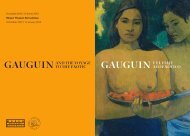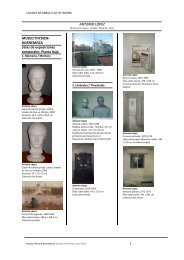Folleto de la exposición - Museo Thyssen-Bornemisza
Folleto de la exposición - Museo Thyssen-Bornemisza
Folleto de la exposición - Museo Thyssen-Bornemisza
- No tags were found...
You also want an ePaper? Increase the reach of your titles
YUMPU automatically turns print PDFs into web optimized ePapers that Google loves.
temáticas que iba a <strong>de</strong>sarrol<strong>la</strong>r posteriormente en su pintura. Los grabados<strong>de</strong> Hopper fueron muy bien recibidos en el mundo artístico <strong>de</strong> NuevaYork y en 1923 el <strong>Museo</strong> <strong>de</strong> Brooklyn adquirió uno <strong>de</strong> ellos. Era <strong>la</strong> primeraobra <strong>de</strong>l artista que entraba en un museo.Des<strong>de</strong> sus años <strong>de</strong> formación en <strong>la</strong> New York School of Art Hoppertuvo ocasión <strong>de</strong> familiarizarse con <strong>la</strong> práctica <strong>de</strong> <strong>la</strong> acuare<strong>la</strong>, una técnicaque contaba con antece<strong>de</strong>ntes importantes en <strong>la</strong> tradición artística norteamericana.Hacia finales <strong>de</strong> <strong>la</strong> segunda década <strong>de</strong>l siglo XX comenzó atrabajar en una serie <strong>de</strong> acuare<strong>la</strong>s <strong>de</strong> tema paisajístico. Seguía con ello uncamino que en <strong>la</strong> generación anterior había abierto el pintor norteamericanoWinslow Homer. A diferencia <strong>de</strong> Homer, Hopper no se interesabapor <strong>la</strong> naturaleza, ni por el paisaje rural, sino que se centraba en vistasurbanas o suburbanas. En 1925 el marchante Frank Rehn mostró ensu galería un conjunto <strong>de</strong> acuare<strong>la</strong>s <strong>de</strong> Hopper. Fue <strong>la</strong> primera exposiciónindividual <strong>de</strong>l artista y se vendieron todas <strong>la</strong>s obras expuestas. El éxitopermitió que Hopper abandonara su trabajo <strong>de</strong> ilustrador para <strong>de</strong>dicarseexclusivamente a <strong>la</strong> pintura. Tenía entonces 43 años.subsequently <strong>de</strong>velop in his paintings. These etchings were extremelywell received by the American art world and by museums and in 1923 theBrooklyn Museum acquired one of them, which was thus the first workby Hopper to enter a museum.During his years of training at the New York School of Art, Hopper learnedthe technique of watercolour, which had important prece<strong>de</strong>nts in theAmerican tradition. Around the end of the second <strong>de</strong>ca<strong>de</strong> of the 20 th centuryhe began to work on a series of watercolours on <strong>la</strong>ndscape subjects,following a direction marked out by the American artist Winslow Homer.In contrast to Homer, Hopper’s focus was not that of nature nor the rural<strong>la</strong>ndscape but rather urban or suburban views. In 1925 the art <strong>de</strong>aler FrankRehn showed a group of Hopper’s watercolours at his gallery in what wasthe artist’s first solo exhibition. All the works exhibited were sold, a successthat allowed Hopper to give up his work as an illustrator and <strong>de</strong>votehimself entirely to painting. By this date he was forty-three.
















